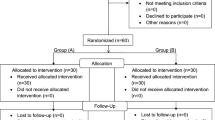Abstract
Introduction
Reducing the percutaneous nephrolithotomy (PCNL) tract size reduces the morbidity associated with the procedure. Prolonged procedure time is a concern. Modification in technique required is to fragment the stone into smaller particles and remove them using the vacuum cleaner effect. This prospective study compares the efficacy and morbidity of reducing the tract size from the standard 24–16.5 Fr for stones sized from 16 to 30 mm.
Methods
123 patients were enrolled in this prospective study and distributed into 2 groups based on the tract size used (group A 16.5/17.5 Fr Miniperc, N = 61 and group B: 22/24 Fr standard PCNL, N = 62). Critical factors assessed were procedure time, fluoroscopy time, blood loss, pain score, stone clearance status and complications.
Results
Both the groups were comparable with respect to age, creatinine and stone size. The blood loss (hemoglobin and PCV drop) was significantly less for group A (p < 0.001). Both the groups were comparable with regards to the pain score (p > 0.05). Nephrostomy was placed in 3 patients in group A and 14 patients in group B (p = 0.01). There was no significant difference in the procedure time amongst the 2 groups. A total of 9 patients (4 in group A and 5 in group B) had residual fragments greater than 3 mm.
Conclusion
The 16.5 Fr Miniperc tract offers lower morbidity in terms of blood loss and maintains stone clearance comparable to larger 24 Fr tract size. It should be the ideal size used for medium sized renal stones.



Similar content being viewed by others
References
Turk C, Knoll T, Petrik A et al (2015) Guidelines on urolithiasis. European Association of Urology. http://uroweb.org/wp-content/uploads/22-Urolithiasis_LR_full.pdf
Seitz C, Desai M, Häcker A et al (2012) Incidence, prevention, and management of complications following percutaneous nephrolitholapaxy. Eur Urol 61:146–158
Yamaguchi A, Skolarikos A, Buchholz NP et al (2011) Operating times and bleeding complications in percutaneous nephrolithotomy: a comparison of tract dilation methods in 5,537 patients in the Clinical Research Office of the Endourological Society Percutaneous Nephrolithotomy Global Study. J Endourol 25:933–939
Kukreja R, Desai M, Patel S et al (2004) Factors affecting blood loss during percutaneous nephrolithotomy: prospective study. J Endourol 18:715–722
Jackman SV, Docimo SG, Cadeddu JA et al (1998) The “mini-perc” technique: a less invasive alternative to percutaneous nephrolithotomy. World J Urol 16:371
Schilling D, Hüsch T, Bader M et al (2015) Nomenclature in PCNL or The Tower Of Babel: a proposal for a uniform terminology. World J Urol 33:1905
Giusti G, Piccinelli A, Taverna G et al (2007) Miniperc? No, thank you! Eur Urol 51:810–815
Mishra S, Sharma R et al (2011) Prospective comparative study of Miniperc and standard PNL for treatment of 1 to 2 cm size renal stone. BJU Int 108:896–900
Knoll T, Wezel F, Michel MS et al (2010) Do patients benefit from miniaturized tubeless percutaneous nephrolithotomy? A comparative prospective study. J Endourol 24(7):1075–1079
Cheng F, Yu W, Zhang X et al (2010) Minimally invasive tract in percutaneous nephrolithotomy for renal stones. J Endourol 24(10):1579–1582
Zhong W, Zeng G, Wu W et al (2011) Minimally invasive percutaneous nephrolithotomy with multiple mini tracts in a single session in treating staghorn calculi. Urol Res 39:117–122
Zeng G et al (2013) Minimally Invasive PCNL for simple and complex renal calyceal stones: a comparative analysis of more than 10000 cases. J Endourol 27(10):1203–1208
Zhu W, Liu Y, Liu L et al (2015) Minimally invasive versus standard percutaneous nephrolithotomy: a meta-analysis. Urolithiasis 43(6):563–570
Lange JN, Gutierrez-Aceves J (2017) Comparative outcomes of conventional PCNL and miniaturized PCNL in the treatment of kidney stones: does a miniaturized tract improve quality of care? Urol Pract. https://doi.org/10.1016/j.urpr.2017.04.003
Nicklas AP, Schilling D, Bader MJ, Herrmann TRW, Nagele U (2015) The vacuum cleaner effect in minimally invasive percutaneous nephrolitholapaxy. WJU 33:1847–1853
Ganesamoni R, Sabnis RB, Mishra S, Parekh N, Ganpule A, Vyas JB, Jagtap J, Desai M (2013) Prospective randomized controlled trial comparing laser lithotripsy with pneumatic lithotripsy in Miniperc for renal calculi. J Endourol 27(12):1444–1449
Teichman JM, Bellman GC et al (1998) Holmium:YAG lithotripsy yields smaller fragments than lithoclast, pulsed dye laser or electrohydraulic lithotripsy. J Urol 159(1):17–23
Olbert P, Weber J, Hegel A et al (2003) Combining lithoclast and ultrasound power in one device for percutaneous nephro-lithotomy: in vitro results of a novel and highly effective technology. Urology 61:55–59
Chew BN, Matteliano AA et al (2017) Benchtop and initial clinical evaluation of the shockpulse stone eliminator in percutaneous nephrolithotomy. J Endourol 31:191–197
Okhunov Z, del Junco M, Yoon R et al (2014) In vitro evaluation of LithAssist: a novel combined holmium laser and suction device. J Endourol 28:980–984
Dauw CA, Borofsky MS, York N, Lingeman JE (2016) A usability comparison of laser suction handpieces for percutaneous nephrolithotomy. J Endourol 30:1165–1168
Singh A, Jairath A, Chhabra J, Mishra S, Ganpule A, Sabnis R, Desai M (2016) Laser with suction as an energy source in mini percutaneous nephrolithotomy: MPUH experience. J Endourol Videourol. https://doi.org/10.1089/vid.2016.0007
Lu Y, Ping JG, Zhao XJ et al (2013) Randomized prospective trial of tubeless versus conventional minimally invasive percutaneous nephrolithotomy. World J Urol 31:1303–1307
Desai MR, Kukreja R, Desai MM et al (2004) A prospective randomized comparison of type of nephrostomy drainage following percutaneous nephrostolithotomy: large bore versus small bore versus tubeless. J Urol 172:565–567
Desai J et al (2016) Prospective outcomes of ultra mini percutaneous nephrolithotomy: a consecutive cohort study. J Urol 195:741–746
Sountoulides P, Metaxa L, Cindolo L (2013) Is computed tomography mandatory for the detection of residual stone fragments after percutaneous nephrolithotomy? J Endourol 27(11):1341–1348
Author information
Authors and Affiliations
Corresponding author
Rights and permissions
About this article
Cite this article
Kukreja, R.A. Should mini percutaneous nephrolithotomy (MiniPNL/Miniperc) be the ideal tract for medium-sized renal calculi (15–30 mm)?. World J Urol 36, 285–291 (2018). https://doi.org/10.1007/s00345-017-2128-z
Received:
Accepted:
Published:
Issue Date:
DOI: https://doi.org/10.1007/s00345-017-2128-z



